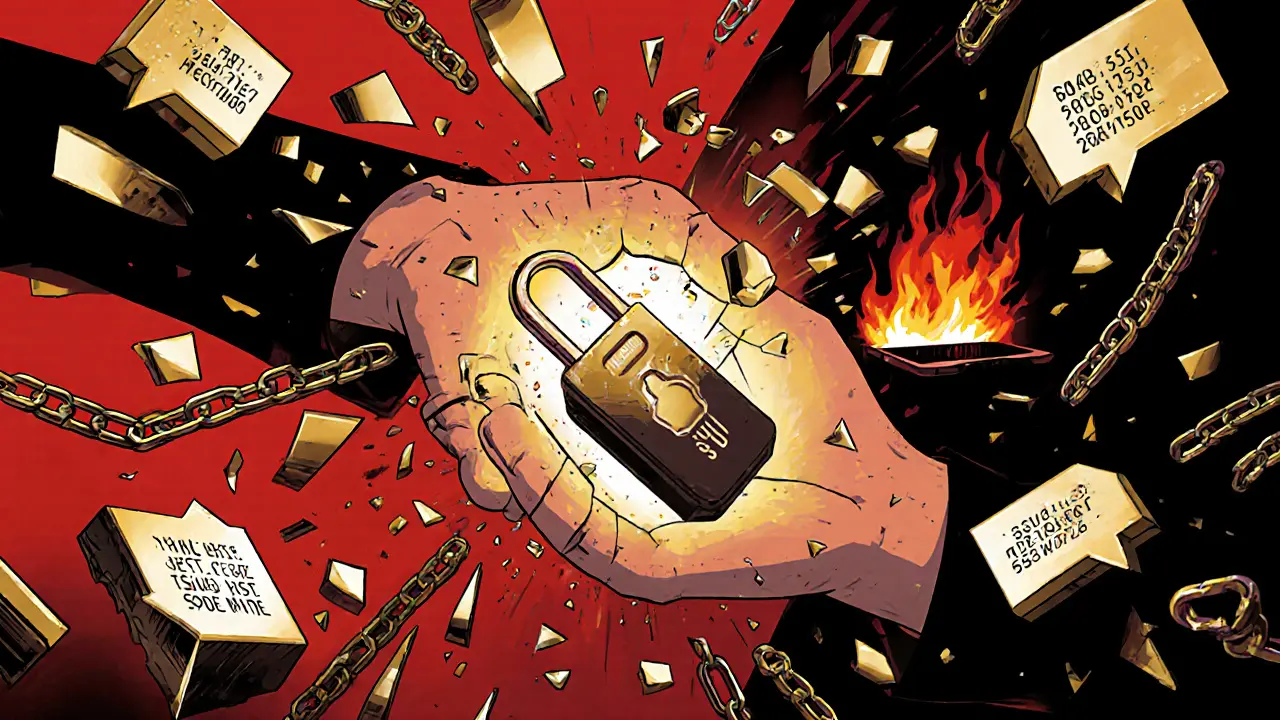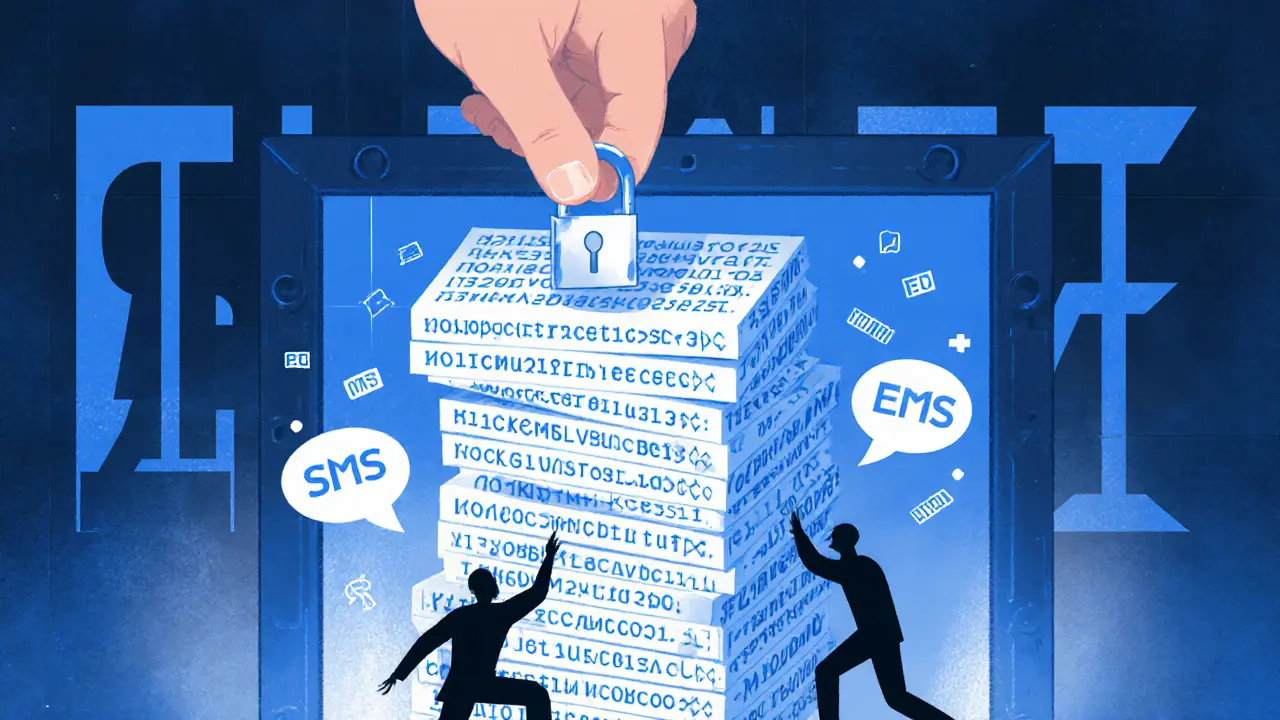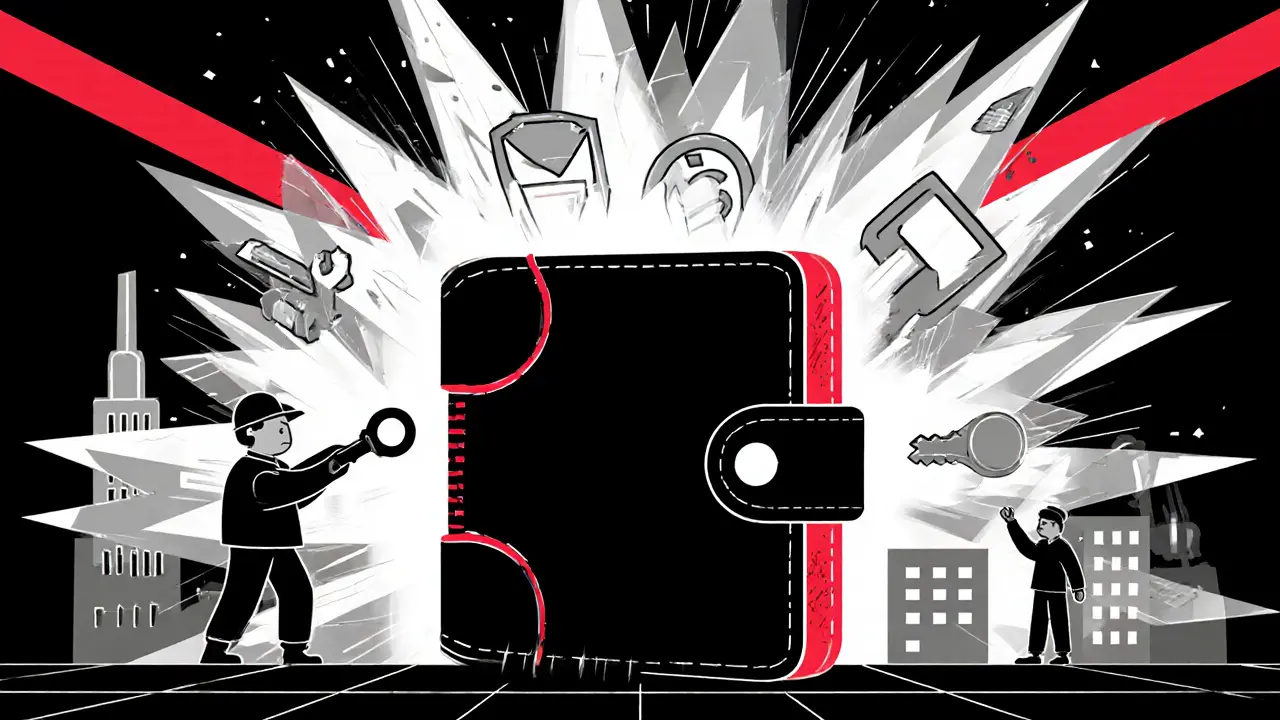2FA Recovery Methods: Secure Ways to Regain Access to Your Blockchain Accounts
 Aug, 19 2025
Aug, 19 2025
Losing access to your blockchain wallet or exchange account isn’t just inconvenient-it can mean losing thousands of dollars. Two-factor authentication (2FA) keeps your assets safe, but if your phone dies, your SIM gets swapped, or you lose your security key, you’re locked out. That’s where 2FA recovery methods come in. Without a solid recovery plan, even the strongest 2FA setup becomes a trap. Most people think 2FA is enough. It’s not. The real vulnerability isn’t the 2FA itself-it’s how you recover from it.
Why 2FA Recovery Matters More Than You Think
Blockchain accounts don’t have customer service lines. No one can reset your password. No one can verify your identity with a driver’s license. If you lose access and haven’t set up recovery, your crypto is gone forever. In 2023, over 82% of individual account takeovers targeting crypto users succeeded because of weak recovery options-not because hackers broke 2FA. They exploited the backup plan.
Microsoft reported that 18% of breaches in organizations with mandatory 2FA happened because users couldn’t recover access-and attackers used that window to reset passwords, change recovery emails, and drain accounts. This isn’t theoretical. In 2022, a single SIM swap attack on T-Mobile let hackers take over 37 million accounts. Many of those users had 2FA enabled, but relied on SMS as their only backup. It didn’t save them.
Backup Codes: The Simplest (and Most Misused) Solution
When you set up 2FA on Coinbase, MetaMask, or your exchange, you’re usually given a set of 10 one-time backup codes. These are 8-16 character strings like 7B9K-P2M4-R8XZ. Each code works once. After you use one, it’s gone. Google and Microsoft recommend generating at least 10 and storing them offline.
Here’s the problem: 57% of people store these codes in unencrypted notes apps, email drafts, or cloud folders. That’s like writing your house key and leaving it taped under the mat. In 2023, Google’s internal data showed 12% of backup code recovery attempts were fraudulent-because the codes were already compromised.
Best practice? Print them. Put them in a fireproof safe. Or store them in a password manager with a strong master password and 2FA enabled (yes, even your password manager needs 2FA). Reddit users who successfully recovered accounts after losing phones consistently mentioned using a password manager like Bitwarden or 1Password for backup codes. Those who saved them in Google Docs? Most never got back in.
SMS Recovery: The Dangerous Illusion
It’s still the most common recovery method. 63% of financial services and 78% of consumer apps still offer SMS-based 2FA recovery. It’s easy. You click “Send code to my phone,” and you get a text. But it’s also the weakest link.
SIM swapping attacks-where hackers convince your mobile carrier to transfer your number to a new SIM-have become routine. The FBI’s IC3 reported that in 2023, 37% of all 2FA-related account takeovers used this method. In one case, a crypto trader lost $48,000 when his number was ported while he was asleep. The attacker got the SMS code, reset his email, and drained his wallet.
NIST (the National Institute of Standards and Technology) has explicitly warned against SMS since 2017. By 2026, the U.S. government plans to ban SMS recovery for all federal systems. If you’re still using it for your crypto accounts, you’re not secure-you’re just waiting to be targeted.

Hardware Security Keys: The Gold Standard
YubiKey, Titan Security Key, and other FIDO2-compliant hardware tokens are the most secure recovery option available today. These small USB or NFC devices generate cryptographic proofs-not codes-that can’t be phished, intercepted, or cloned. When you set up a YubiKey as a recovery method, you’re not relying on a network or a phone. You’re relying on physics.
Yubico’s 2023 security report showed zero successful attacks against FIDO2-based recovery across 12 million deployed devices. Google’s Advanced Protection Program now requires three physical keys for recovery and has cut targeted account takeovers by 99.8%. That’s not marketing. That’s math.
For blockchain users, this means: buy one. Keep it in your wallet. Keep a second one at home. Register both with your exchange or wallet. If you lose your phone, you plug in the key. Done. No codes. No texts. No guesswork.
Email Recovery: Better Than SMS, But Still Risky
Email recovery is often the fallback when SMS and backup codes fail. It’s more secure than SMS because it doesn’t rely on cellular networks. But it’s only as strong as your email account.
In 2023, 24% of all secondary attacks on 2FA-protected accounts started with a compromised email. Twitter (now X) had a major breach where attackers reset passwords using email recovery after gaining access to users’ inboxes. The same happened to over 4,400 verified accounts.
Use email recovery only if your email account has its own strong 2FA-preferably hardware key-based. Never use the same password for your email and your crypto wallet. And never use a free email provider like Gmail or Outlook as your only recovery email if you’re holding significant crypto. Consider a dedicated, encrypted email service like ProtonMail with a hardware key attached.
Adaptive Recovery: The Future Is Context-Aware
Big platforms like Microsoft Azure AD and Okta are moving beyond static recovery options. They now use “adaptive recovery”-analyzing your location, device, login time, and behavior to decide if a recovery request is legitimate.
For example: If you normally log in from Edinburgh at 9 a.m. on a MacBook, and suddenly someone tries to recover your account from Lagos at 3 a.m. using a new Android phone, the system blocks it-even if they have your backup code. That’s what’s called risk-based authentication.
By 2024, 68% of Fortune 500 companies use adaptive recovery. It’s not yet common in consumer crypto apps, but it’s coming. The FIDO Alliance’s new Passkey Recovery specs, announced in June 2024, will let you recover accounts using trusted devices like your laptop or tablet-no codes, no SMS, no phone. Apple, Google, and Microsoft are all building it. Expect it to roll out to major crypto platforms by mid-2025.

What You Should Do Right Now
Don’t wait for a breach. Don’t wait until your phone dies. Do this today:
- Generate backup codes for every crypto account you own. Don’t skip this.
- Print them. Put them in a safe. Don’t store them digitally unless encrypted.
- Buy one FIDO2 hardware key (YubiKey 5Ci or equivalent). Register it as a recovery method.
- Buy a second one. Leave it with a trusted person or in a different location.
- Disable SMS recovery everywhere. If the platform won’t let you, consider switching.
- Ensure your recovery email has its own hardware key 2FA.
- Test your recovery process. Log out. Try to get back in. If you can’t, you haven’t set it up right.
It takes 17 minutes to set this up. That’s less time than it takes to watch a YouTube video. But it’s the difference between losing your life savings and keeping it safe.
Common Mistakes (And How to Avoid Them)
- Mistake: Using the same backup code across multiple accounts. Solution: Generate unique codes for each platform. Reusing them means one breach = all accounts gone.
- Mistake: Relying on Authy or Google Authenticator as your only backup. Solution: These apps can sync-but if your phone is stolen or wiped, you’re still locked out unless you’ve exported your keys. Use them as a convenience, not a safety net.
- Mistake: Thinking “I’ll remember my password.” Solution: Even the best passwords can be guessed or leaked. Recovery isn’t about remembering-it’s about having a backup you can physically access.
- Mistake: Ignoring recovery because “I don’t have much crypto.” Solution: Attackers don’t care how much you have. They automate attacks. One compromised account can be sold on the dark web for $500-even if it only holds $200.
Final Thought: Security Is a Habit, Not a Feature
Blockchain gives you control. But control means responsibility. 2FA isn’t magic. Recovery isn’t optional. The most secure wallet in the world is useless if you can’t get into it.
Hardware keys, printed codes, and verified emails aren’t just best practices-they’re survival tools. Every major breach in crypto history followed the same pattern: strong 2FA, weak recovery. Don’t be the next statistic.
Set it up. Test it. Keep it safe. Your future self will thank you.
What’s the best 2FA recovery method for crypto users?
The best method is a combination of printed backup codes and at least one FIDO2 hardware security key (like a YubiKey). Hardware keys are phishing-resistant and don’t rely on phones or networks. Backup codes act as a physical fallback. Never rely on SMS or email alone.
Can I recover my crypto if I lose my phone and don’t have backup codes?
If you don’t have backup codes or a hardware key, recovery is nearly impossible. Most decentralized wallets and exchanges don’t offer account recovery. You’ll likely lose access permanently. That’s why setting up recovery before you need it is critical.
Are backup codes safe if I store them in a password manager?
Yes-if your password manager has strong 2FA enabled (preferably with a hardware key). Storing codes in an encrypted password manager is safer than keeping them in a text file or email. Just make sure your master password is strong and unique.
Why is SMS recovery so dangerous for crypto?
SMS can be intercepted through SIM swapping, where attackers trick your mobile carrier into transferring your number. Once they control your phone number, they receive your 2FA codes. This method was used in over 37% of 2FA-related breaches in 2023. It’s the most common attack vector for crypto accounts.
Should I use multiple authenticator apps for backup?
It’s a good idea to use two authenticator apps on different devices-for example, Google Authenticator on your phone and Authy on your tablet. But this isn’t a replacement for backup codes or hardware keys. Authenticator apps can still be lost if your device is damaged or stolen. Use them as a secondary layer, not your primary recovery.
What’s the difference between a security key and a backup code?
A security key is a physical device that uses cryptography to prove your identity. It can’t be copied or phished. A backup code is a one-time-use string of letters and numbers. It’s simpler but can be stolen if stored insecurely. Use both: the key for daily access, the code for emergencies.
Anna Mitchell
October 29, 2025 AT 00:27Just set up my YubiKey last week after almost losing everything in a phishing scam. Best 17 minutes of my life. Seriously, if you haven't done this yet, stop scrolling and do it now. Your future self will high-five you. 🙌
Pranav Shimpi
October 29, 2025 AT 01:33backup codes in passwrod manger is fine but dont use google or microsofts free ones. use bitwarden or 1password with 2fa enabled. i lost my phone and got back in cause i had it in bitwarden. also print one copy. paper never dies. 😅
jummy santh
October 30, 2025 AT 19:45As a Nigerian crypto enthusiast, I can confirm that SMS recovery is a death sentence here. SIM swaps are so common that even banks now refuse to use them. I carry my YubiKey in my wallet like a lucky charm. One key for home, one for travel. Never rely on your phone number. Your assets deserve better than a telecom glitch.
Kirsten McCallum
October 30, 2025 AT 22:21Security is a habit. Not a feature. You’re not special. Your crypto isn’t safe because you’re ‘careful.’ It’s safe because you did the boring stuff. Stop romanticizing tech. Do the work.
Henry Gómez Lascarro
October 31, 2025 AT 06:42Everyone’s acting like hardware keys are some magic bullet, but let’s be real - most people can’t even keep their keys from getting lost. I’ve seen guys buy a YubiKey, then leave it in their coat pocket for a year, and then wonder why they can’t log in. And don’t even get me started on people who print backup codes and then put them in the same drawer as their tax returns. What’s next? Writing passwords on sticky notes and putting them on the monitor? This isn’t security, it’s performance art. If you’re not storing your keys in a biometric vault with GPS tracking and a blockchain timestamp, you’re still doing it wrong. Also, why are we still talking about SMS? Everyone knows it’s dead. The real problem is that people think recovery is something you set up once and forget. It’s a ritual. Like brushing your teeth. But nobody does it right.
Will Barnwell
October 31, 2025 AT 19:34YubiKey? Overkill. I just use Authy with cloud backup. Never had an issue. Also, why are we pretending crypto is different from regular banking? Nobody uses hardware keys for their Chase account. Chill.
Lawrence rajini
November 1, 2025 AT 16:09Just got my second YubiKey in the mail! 🎉 Seriously though, if you're still using SMS for crypto recovery you're basically leaving your front door wide open with a sign that says 'Hey thief, I'm asleep.' Do the thing. It takes 10 minutes. Your future self will cry happy tears. 💪🔐
Matt Zara
November 2, 2025 AT 14:36Biggest thing I learned? Test your recovery before you need it. I did it last month - logged out, tried to get back in with my backup code and key. Took 3 minutes. Felt like a boss. Don't wait for disaster. Do it now. It's not hard. Just annoying. And annoying is better than broke.
Jean Manel
November 2, 2025 AT 23:47People who use backup codes in Google Drive are just asking for their life savings to be turned into NFTs of a cat wearing a hat. You’re not ‘organized.’ You’re negligent. And if you think Authy is safe because it ‘syncs’ - congrats, you’ve just given hackers a backdoor to your entire digital identity. This isn’t tech advice. It’s a public service announcement.
William P. Barrett
November 3, 2025 AT 10:19There’s a deeper truth here: we treat digital assets like they’re abstract, but they’re not. They’re extensions of our identity. Losing access isn’t losing money - it’s losing control over a part of yourself. That’s why recovery isn’t a feature. It’s a philosophical act. The hardware key isn’t a tool. It’s a promise you make to your future self: ‘I won’t let fear make me careless.’
Cory Munoz
November 4, 2025 AT 16:58I used to think I was too careful to get hacked. Then I lost my phone. Turned out, I’d never printed my codes. Learned the hard way. Now I keep one key in my wallet, one with my mom. And I check my recovery setup every 6 months. Not because I’m paranoid. Because I care. 😊
Jasmine Neo
November 6, 2025 AT 02:38Let’s cut through the crypto bro nonsense. YubiKeys are expensive. Most people can’t afford them. And yet you’re acting like everyone should just buy one. Meanwhile, you’re using a corporate-grade security stack while your neighbor is trying to recover $300 in BTC. This isn’t about security. It’s about elitism dressed up as best practice. Not everyone lives in a Silicon Valley bubble. Stop preaching. Start solving.
Ron Murphy
November 7, 2025 AT 14:53Interesting how the article assumes everyone has access to a printer, a fireproof safe, or even a stable internet connection to set up Bitwarden. In many parts of the world, ‘printing backup codes’ is a luxury. The real gap isn’t in user behavior - it’s in infrastructure. We need low-bandwidth, offline-first recovery options. Until then, telling people to ‘just buy a YubiKey’ is tone-deaf.
Prateek Kumar Mondal
November 9, 2025 AT 04:36Anna Mitchell
November 10, 2025 AT 08:02Just read @805’s comment and I get it. Not everyone can afford a YubiKey. But here’s the thing - you can get a basic FIDO2 key for under $20. I bought mine on Amazon during a sale. It’s not about being elite. It’s about not being a target. Even $30 is better than losing $30,000. I get it’s not perfect. But it’s a step. And steps matter.